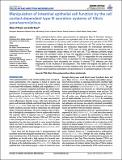| dc.contributor.author | O'Boyle, Nicky | |
| dc.contributor.author | Boyd, Aoife | |
| dc.date.accessioned | 2017-07-10T15:21:17Z | |
| dc.date.available | 2017-07-10T15:21:17Z | |
| dc.date.issued | 2014-01-10 | |
| dc.identifier.citation | O'Boyle, Nicky, & Boyd, Aoife. (2014). Manipulation of intestinal epithelial cell function by the cell contact-dependent type III secretion systems of Vibrio parahaemolyticus. Frontiers in Cellular and Infection Microbiology, 3(114). doi: 10.3389/fcimb.2013.00114 | en_IE |
| dc.identifier.issn | 2235-2988 | |
| dc.identifier.uri | http://hdl.handle.net/10379/6665 | |
| dc.description.abstract | Vibrio parahaemolyticus elicits gastroenteritis by deploying Type III Secretion Systems (TTSS) to deliver effector proteins into epithelial cells of the human intestinal tract. The bacteria must adhere to the human cells to allow colonization and operation of the TTSS translocation apparatus bridging the bacterium and the host cell. This article first reviews recent advances in identifying the molecules responsible for intercellular adherence. V parahaemolyticus possesses two TTSS, each of which delivers an exclusive set of effectors and mediates unique effects on the host cell. TTSS effectors primarily target and alter the activation status of host cell signaling proteins, thereby bringing about changes in the regulation of cellular behavior. TTSS1 is responsible for the cytotoxicity of V parahaemolyticus, while TTSS2 is necessary for the enterotoxicity of the pathogen. Recent publications have elucidated the function of several TTSS effectors and their importance in the virulence of the bacterium. This review will explore the ability of the TTSS to manipulate activities of human intestinal cells and how this modification of cell function favors bacterial colonization and persistence of V parahaemolyticus in the host. | en_IE |
| dc.description.sponsorship | Nicky O'Boyle was supported by Science Foundation Ireland, grant no. 08/RFP/GEN1225 to the Pathogenic Mechanisms Research Group, NUI Galway. | en_IE |
| dc.format | application/pdf | en_IE |
| dc.language.iso | en | en_IE |
| dc.publisher | Frontiers Media | en_IE |
| dc.relation.ispartof | Frontiers In Cellular And Infection Microbiology | en |
| dc.rights | Attribution-NonCommercial-NoDerivs 3.0 Ireland | |
| dc.rights.uri | https://creativecommons.org/licenses/by-nc-nd/3.0/ie/ | |
| dc.subject | TTSS | en_IE |
| dc.subject | MshA | en_IE |
| dc.subject | Vibrio parahaemolyticus | en_IE |
| dc.subject | Effector | en_IE |
| dc.subject | Intestinal cells | en_IE |
| dc.subject | Mannose sensitive hemagglutinin | en_IE |
| dc.subject | Adhesion molecule 7 | en_IE |
| dc.subject | Thermostable direct hemolysin | en_IE |
| dc.subject | Actin filament nucleation | en_IE |
| dc.subject | Bacterial effector VOPL | en_IE |
| dc.subject | Cholerae el tor | en_IE |
| dc.subject | Host cell | en_IE |
| dc.subject | Colonization factor | en_IE |
| dc.subject | Biofilm formation | en_IE |
| dc.subject | Binding domain | en_IE |
| dc.title | Manipulation of intestinal epithelial cell function by the cell contact-dependent type III secretion systems of Vibrio parahaemolyticus | en_IE |
| dc.type | Article | en_IE |
| dc.date.updated | 2017-07-10T11:43:28Z | |
| dc.identifier.doi | 10.3389/fcimb.2013.00114 | |
| dc.local.publishedsource | https://doi.org/10.3389/fcimb.2013.00114 | en_IE |
| dc.description.peer-reviewed | peer-reviewed | |
| dc.contributor.funder | |~| | |
| dc.internal.rssid | 6513659 | |
| dc.local.contact | Aoife Boyd, Dept. Of Microbiology, Arts/Science Building, Nui Galway. 2404 Email: aoife.boyd@nuigalway.ie | |
| dc.local.copyrightchecked | No | |
| dc.local.version | PUBLISHED | |
| nui.item.downloads | 485 | |


